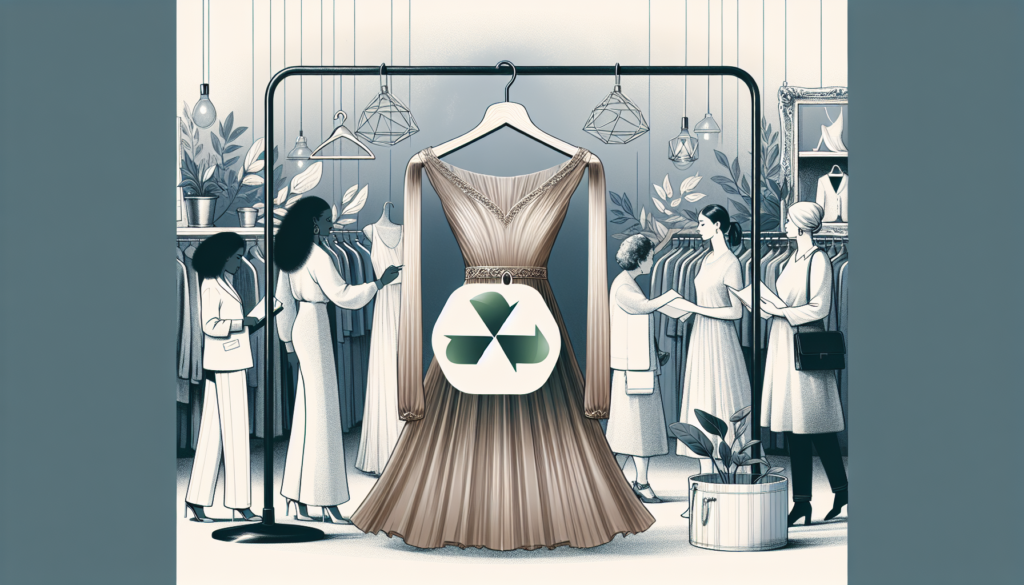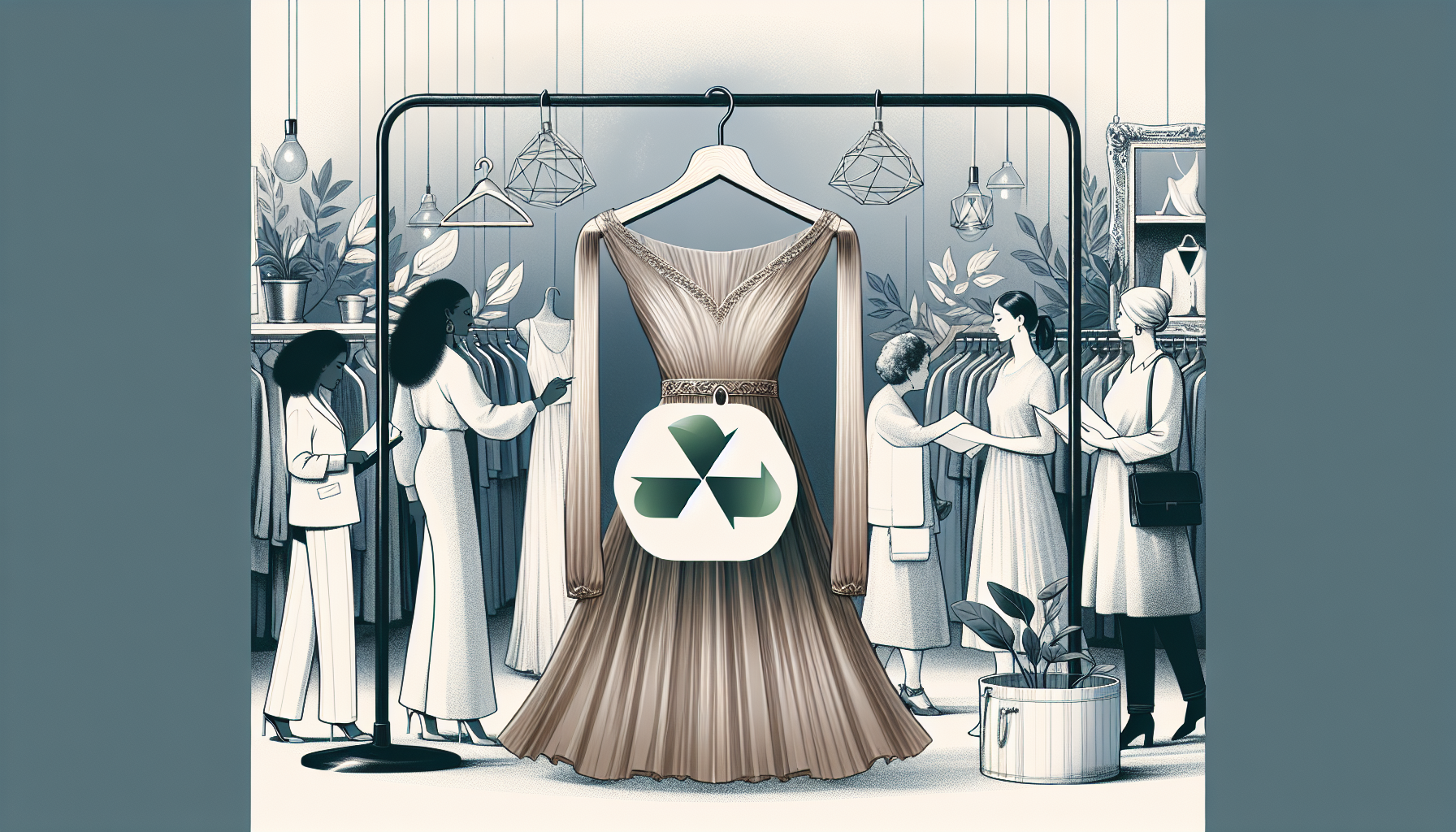Imagine never having to worry about buying clothes again. Imagine a world where you can have a new outfit for every occasion without contributing to the devastating impacts of the fast fashion industry. Sustainable fashion is on the rise, and one of its most promising trends is the concept of renting clothes. By allowing individuals to rent garments instead of buying them, this innovative approach not only helps to reduce waste and carbon emissions, but also provides a more affordable and accessible way to enjoy stylish and trendy pieces. Join the movement and discover how renting clothes is revolutionizing the fashion industry and paving the way towards a more sustainable future.

The Concept of Sustainable Fashion
Definition of sustainable fashion
Sustainable fashion refers to the practice of creating and designing clothing in an environmentally and socially conscious manner. It takes into consideration the entire lifecycle of a garment, from the sourcing of materials to its production, distribution, and disposal. Sustainable fashion seeks to minimize the negative impacts on the environment and society, while maximizing positive contributions.
Importance of sustainable fashion
Sustainable fashion is increasingly important in today’s world due to the environmental and social challenges posed by the fashion industry. The fashion industry is known for its significant contribution to pollution, waste generation, and resource depletion. By embracing sustainable fashion practices, we can mitigate these negative impacts, reduce carbon emissions, and promote ethical and fair trade practices. Moreover, sustainable fashion encourages a shift towards a circular economy, where resources are used more efficiently, reducing the need for constant production and consumption of new clothing.
Current trends in sustainable fashion
In recent years, there has been a noticeable increase in the demand for sustainable fashion. Consumers are now more conscious of the environmental and social impacts of their purchasing decisions. As a result, brands and designers are incorporating sustainable practices into their business models. Some current trends in sustainable fashion include the use of organic and recycled materials, implementing ethical labor practices, promoting transparency in the supply chain, and embracing alternative business models such as clothing rental services.
The Rise of the Sharing Economy
What is the sharing economy
The sharing economy refers to a socio-economic system in which individuals share resources and assets with one another, usually facilitated through digital platforms or networks. It allows people to rent or borrow items they need temporarily, rather than buying and owning them outright. The sharing economy promotes a more collaborative and sustainable approach to consumption, reducing the need for unnecessary production and consumption.
Sharing economy in the fashion industry
The fashion industry has embraced the sharing economy through the introduction of clothing rental services. These platforms allow individuals to rent high-quality clothing items for a limited period of time, eliminating the need to purchase new clothes for every occasion. By sharing clothing items, people can access a wide range of styles and brands, while significantly reducing their environmental footprint.
Benefits of the sharing economy in fashion
The sharing economy in fashion offers several benefits. Firstly, it helps to reduce clothing waste and extend the lifecycle of garments. Instead of items being discarded after limited use, they can be shared and enjoyed by multiple individuals. This reduces the demand for new clothing production and reduces the amount of clothing ending up in landfills. Secondly, the sharing economy promotes a more sustainable use of resources. By renting clothes instead of buying, fewer raw materials and energy are required for production. Lastly, renting clothes can also help individuals save money, as they can access designer and high-quality clothing at a fraction of the cost of purchasing.
The Environmental Impact of Fast Fashion
Problems with fast fashion
Fast fashion refers to the rapid production and consumption of inexpensive clothing, often inspired by the latest fashion trends. While it may be affordable and easily accessible, fast fashion has several negative environmental impacts. Firstly, fast fashion encourages over-consumption and a throwaway mentality, where clothes are worn only a few times before being discarded. This leads to excessive waste and contributes to the depletion of natural resources. Secondly, fast fashion is often produced using cheap labor and unethical working conditions, exploiting workers and violating their fundamental rights.
Waste generation and pollution
The fast fashion industry generates a staggering amount of waste. Clothes that are poorly made or fall out of trend end up in landfills, where they take years to decompose. Additionally, the production process of fast fashion involves the use of toxic chemicals and dyes, which can pollute water sources and harm ecosystems. From the cultivation of raw materials to the disposal of garments, the fast fashion industry leaves a significant environmental footprint.
Resource depletion
Fast fashion relies heavily on the extraction of natural resources such as water, cotton, and oil. The production of cotton, for example, requires large amounts of water and pesticides, putting a strain on these resources and contributing to water pollution. The extraction of oil for synthetic fabrics also contributes to environmental degradation, as it is a non-renewable resource. By promoting a more sustainable and circular approach to fashion, we can reduce the depletion of precious resources and conserve the environment for future generations.
Advantages of Renting Clothes
Reducing clothing waste
Renting clothes offers a practical solution to reduce clothing waste. Instead of buying new clothes for every occasion, individuals can rent outfits that suit their needs, eliminating the need to purchase items that may only be worn once or twice. By extending the lifespan of clothing and reducing the demand for new production, we can significantly reduce the amount of clothing ending up in landfills and contribute to a more sustainable fashion industry.
Lowering environmental footprint
Renting clothes also helps to lower our individual environmental footprint. The production of new clothing requires the use of precious resources such as water, energy, and raw materials. By renting clothes instead of buying, we can conserve these resources and reduce the carbon emissions associated with the fashion industry. Additionally, renting clothes often involves cleaning and maintenance services provided by the rental platform, ensuring that clothes are well taken care of and can be reused multiple times.
Saving money
One of the advantages of renting clothes is the potential for significant cost savings. Designer clothing and high-quality items can be expensive to purchase, especially if they are only worn a few times. Renting allows individuals to access these items at a fraction of the cost, making fashion more affordable and accessible. Moreover, by renting clothes instead of constantly buying new ones, individuals can save money in the long run and allocate their resources to other priorities.

Types of Clothing Rental Services
Online platforms
Online platforms for clothing rental have gained popularity in recent years. These platforms allow individuals to browse through a wide range of clothing options, select their desired outfits, and have them delivered to their doorstep. They offer convenience and flexibility, as individuals can rent clothes for specific events or periods of time, without the need to physically visit a store.
Brick-and-mortar stores
Brick-and-mortar stores that focus on clothing rental also exist. These stores provide a physical space where individuals can try on clothes and seek personal assistance from staff. While it may involve more effort to visit a physical store, brick-and-mortar rental stores offer a unique experience and the opportunity to directly interact with the clothes before renting them.
Subscription-based services
Subscription-based services combine the convenience of online platforms with the benefits of regular access to a curated collection of clothing. With a subscription, individuals pay a monthly fee and receive a set number of clothing items to use and return as desired. This model allows for variety and flexibility, as individuals can constantly update their wardrobe without the need for repetitive purchasing.
How Clothing Rental Works
Selecting clothes
When renting clothes, individuals can browse through the available collection and select the items they wish to rent. Online platforms often provide detailed descriptions and images of each garment, ensuring that individuals can make an informed choice. Taking into consideration their personal style and the occasion, individuals can select outfits that suit their needs and preferences.
Duration of rental
The duration of rental can vary depending on the rental platform and the individual’s needs. Some platforms offer rentals for a specific number of days, while others provide monthly subscriptions. Individuals can choose the rental period that works best for them, taking into account the specific event or the desired variety in their wardrobe.
Cleaning and maintenance
One of the advantages of clothing rental services is that they take care of the cleaning and maintenance of the rented garments. After individuals return the clothes, the rental platform ensures that the items are thoroughly cleaned, sanitized if necessary, and prepared for the next rental. This ensures that every rented item is in good condition and ready to be enjoyed by someone else.
Popular Clothing Rental Platforms
Rent the Runway
Rent the Runway is a widely recognized and popular clothing rental platform. It offers a vast selection of designer clothing and accessories for rent, providing individuals with access to high-quality items at affordable prices. Rent the Runway offers various rental options, including one-time rentals and subscription plans, catering to different needs and preferences.
Le Tote
Le Tote is another well-known clothing rental platform that focuses on providing a personalized experience. With Le Tote, individuals fill out a style profile, and the platform’s stylists curate a selection of clothing and accessories based on their preferences. Le Tote offers unlimited rentals for a monthly fee, allowing individuals to constantly update their wardrobe and try new styles.
Gwynnie Bee
Gwynnie Bee is a clothing rental platform that specializes in sizes 10-32, catering to a broader range of body types. The platform offers a variety of styles and brands, allowing individuals to find clothing that fits their body and style preferences. Gwynnie Bee operates on a subscription model, providing individuals with a continuous rotation of rental items.
Challenges and Limitations
Limited size and style availability
One limitation of clothing rental services is the limited availability of sizes and styles. Rental platforms may not always carry a comprehensive range of sizes or the latest fashion trends. This can make it challenging for individuals with specific size requirements or fashion preferences to find suitable rental options. However, as the demand for rental services continues to grow, more platforms are working towards expanding their size and style offerings.
Concerns about hygiene and condition
Another challenge of renting clothes is the concern about hygiene and condition. Some individuals may be cautious about wearing clothes that have been previously worn by others, regardless of the cleaning process. However, rental platforms address these concerns by implementing rigorous cleaning and inspection procedures to ensure that clothes are in excellent condition and ready for use.
Return policies and fees
Renting clothes also comes with specific return policies and potential fees. Individuals must adhere to the rental duration and return the clothes on time to avoid any additional charges. Additionally, rental platforms may have specific requirements for the condition in which the clothes should be returned. It is essential for individuals to fully understand and comply with the return policies to ensure a smooth and cost-effective rental experience.
Consumer Attitudes Towards Renting Clothes
Growing acceptance of renting clothes
Consumer attitudes towards renting clothes have shifted positively in recent years. Renting clothes has become more widely recognized as a convenient and sustainable alternative to traditional shopping. As individuals become more aware of the environmental and social impacts of the fashion industry, they are increasingly open to exploring rental options and incorporating them into their lifestyle.
Shifting perceptions of ownership
Renting clothes also reflects a broader shift in consumer perceptions of ownership. In the past, owning a large wardrobe was seen as a status symbol and a measure of success. However, as sustainability and minimalism gain traction, individuals are re-evaluating their relationship with material possessions. Renting clothes allows individuals to enjoy a wide variety of styles and brands without the need for ownership, promoting a sense of freedom and flexibility.
Sustainability as a motivator
Sustainability plays a significant role in motivating consumers to rent clothes. Many individuals are actively seeking ways to reduce their environmental impact and contribute to a more sustainable future. Renting clothes aligns with these goals by reducing waste, lowering carbon emissions, and conserving resources. By choosing rental options, consumers can make a tangible difference in the fashion industry and support brands that prioritize sustainability.
Implications for the Future of Fashion
Changing consumer behavior
The rise of renting clothes signifies a significant shift in consumer behavior and preferences. As individuals become more conscious of the environmental and social impact of their choices, they are increasingly seeking alternatives to traditional shopping. This change in consumer behavior is likely to influence the fashion industry as a whole, encouraging brands to adopt more sustainable practices and offer rental options.
Influence on traditional retail
The rise of renting clothes poses both challenges and opportunities for traditional retail. As consumers opt for rental services, the demand for traditional retail may decrease, impacting sales and profitability. However, traditional retailers have the opportunity to adapt and incorporate rental services into their business models, offering customers a variety of options and catering to the changing demands of the market.
Collaborations and innovation in the industry
The emergence of rental services in the fashion industry has stimulated collaborations and innovation. Brands and designers are exploring partnerships with rental platforms to reach a broader audience and promote their sustainability efforts. Furthermore, the need to address the challenges and limitations of renting clothes has led to advancements in cleaning technologies, sustainable packaging, and logistics solutions. These collaborations and innovations contribute to the overall development and growth of the sustainable fashion industry.
In conclusion, the rise of renting clothes represents a significant shift towards sustainability in the fashion industry. Sustainable fashion practices, such as renting clothes, offer a practical solution to reduce waste, lower the environmental footprint, and promote a circular economy. With the increasing acceptance and demand for rental services, consumers have the power to shape the future of fashion by making more conscious and sustainable choices. By embracing sustainable fashion practices, we can create a more equitable and environmentally friendly fashion industry, ensuring a better future for both the planet and its inhabitants.

